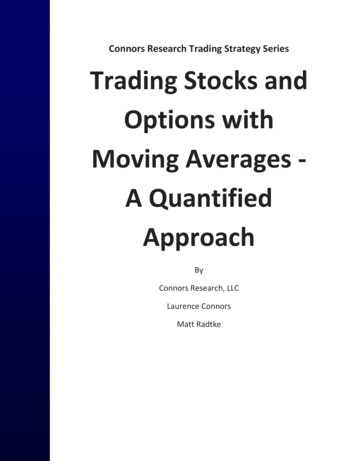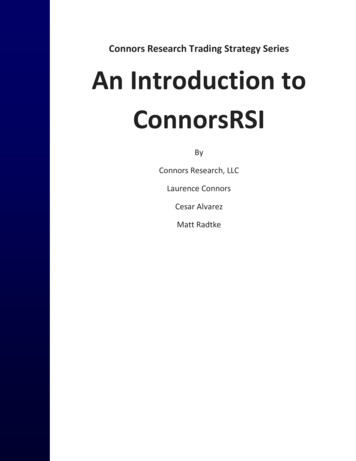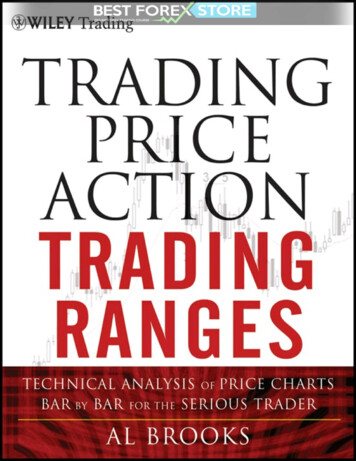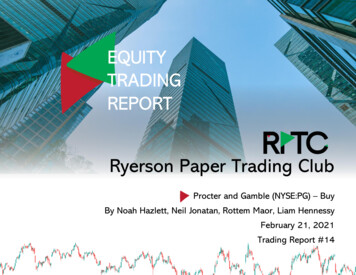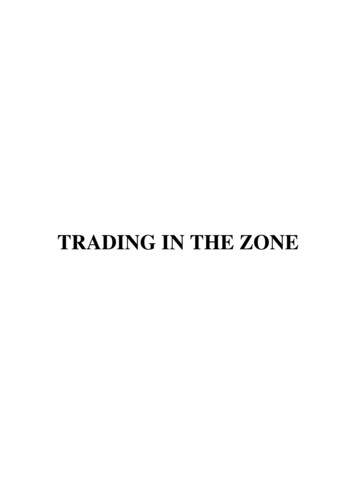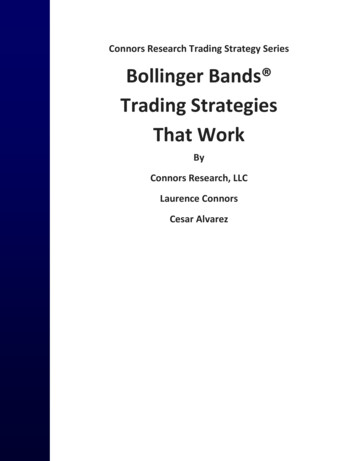
Transcription
Connors Research Trading Strategy SeriesBollinger Bands Trading StrategiesThat WorkByConnors Research, LLCLaurence ConnorsCesar Alvarez
Copyright 2013, Connors Research LLC.ALL RIGHTS RESERVED. No part of this publication may be reproduced, stored in aretrieval system, or transmitted, in any form or by any means, electronic, mechanical,photocopying, recording, or otherwise, without the prior written permission of thepublisher and the author.This publication is designed to provide accurate and authoritative information in regardto the subject matter covered. It is sold with the understanding that the author and thepublisher are not engaged in rendering legal, accounting, or other professional service.Authorization to photocopy items for internal or personal use, or in the internal orpersonal use of specific clients, is granted by Connors Research, LLC, provided that theU.S. 7.00 per page fee is paid directly to Connors Research, LLC, 1-973-494-7333.ISBN 978-0-9886931-9-7Printed in the United States of America.2 Page
DisclaimerBy distributing this publication, Connors Research, LLC, Laurence A. Connors and Cesar Alvarez(collectively referred to as “Company") are neither providing investment advisory services nor acting asregistered investment advisors or broker-dealers; they also do not purport to tell or suggest whichsecurities or currencies customers should buy or sell for themselves. The analysts and employees oraffiliates of Company may hold positions in the stocks, currencies or industries discussed here. Youunderstand and acknowledge that there is a very high degree of risk involved in trading securities and/orcurrencies. The Company, the authors, the publisher, and all affiliates of Company assume noresponsibility or liability for your trading and investment results. Factual statements on the Company'swebsite, or in its publications, are made as of the date stated and are subject to change without notice.It should not be assumed that the methods, techniques, or indicators presented in these products will beprofitable or that they will not result in losses. Past results of any individual trader or trading systempublished by Company are not indicative of future returns by that trader or system, and are not indicativeof future returns which be realized by you. In addition, the indicators, strategies, columns, articles and allother features of Company's products (collectively, the "Information") are provided for informational andeducational purposes only and should not be construed as investment advice. Examples presented onCompany's website are for educational purposes only. Such set-ups are not solicitations of any order tobuy or sell. Accordingly, you should not rely solely on the Information in making any investment. Rather,you should use the Information only as a starting point for doing additional independent research in orderto allow you to form your own opinion regarding investments.You should always check with your licensed financial advisor and tax advisor to determine the suitabilityof any investment.HYPOTHETICAL OR SIMULATED PERFORMANCE RESULTS HAVE CERTAIN INHERENTLIMITATIONS. UNLIKE AN ACTUAL PERFORMANCE RECORD, SIMULATED RESULTS DO NOTREPRESENT ACTUAL TRADING AND MAY NOT BE IMPACTED BY BROKERAGE AND OTHERSLIPPAGE FEES. ALSO, SINCE THE TRADES HAVE NOT ACTUALLY BEEN EXECUTED, THERESULTS MAY HAVE UNDER- OR OVER-COMPENSATED FOR THE IMPACT, IF ANY, OF CERTAINMARKET FACTORS, SUCH AS LACK OF LIQUIDITY. SIMULATED TRADING PROGRAMS INGENERAL ARE ALSO SUBJECT TO THE FACT THAT THEYARE DESIGNEDWITH THE BENEFIT OFHINDSIGHT. NO REPRESENTATION IS BEING MADE THAT ANY ACCOUNT WILL OR IS LIKELY TOACHIEVE PROFITS OR LOSSES SIMILAR TO THOSE SHOWN.Connors Research10 Exchange PlaceSuite 1800Jersey City, NJ 073023 Page
Table of ContentsSection 1A Look at Trading with Bollinger Bands and %b5Section 2The Rules9Section 3Test Results12Section 4The Role of Exits17Section 5Day Trading With Bollinger Bands and %b22Section 6Trading Options with Bollinger Bands and %b25Section 7Additional Notes29AppendixRSI, Historical Volatility, and ADX Calculations314 Page
Section 1A Look at BollingerBands and %b5 Page
Created by legendary money manager and researcher John Bollinger, Bollinger Bands are oneof the most popular indicators applied by traders throughout the world in nearly all markets.It’s rare today to see a chart not accompanied by Bollinger Bands as they’ve become a musthave visualization tool which allows traders to see how overbought or oversold a security is.There has been an abundance of information published on how to trade with Bollinger Bands .Much of it though is discretionary in theory. The how‐to‐use Bollinger Bands informationusually pushes it back to the trader to interpret what the security’s price is doing relevant to itsBands.This Guidebook does not.What you will learn is how to exactly identify overbought and oversold key levels with BollingerBands and applying them knowing what the historical returns have been when they reachedspecific levels.With the Trading with Bollinger Bands Strategy Guidebook, you will learn how to identify thebest historical entry and exit triggers, along with multiple levels of intraday pullbacks toincrease the edges of the Bands. We’ll also teach you various exit points to allow for even moreflexibility in your trading.We looked at every United States stock which has traded on average at least 250,000 shares aday priced above 5 a share from January 2001‐May 2012 (the date we started writing theGuidebook). This includes all stocks along with those that were bought out, delisted, etc. Youare seeing Bollinger Bands , and especially the %b component of Bollinger Bands in play everyday on all liquid stocks for over a decade. From this you will see that the %b component ofBollinger Bands has had significant predictive ability to short‐term prices when it’s properlyapplied. As a whole, you have one of the most robust quantified equity strategies for applyingBollinger Bands .Before describing the strategy, let’s look at exactly what Bollinger Bands are and also what weconsider to be the genius within the Bollinger Bands ‐ the %b calculation ‐ which we willspecifically focus on.6 Page
What Are Bollinger Bands ?Bollinger Bands are used to measure the highness or lowness of the price relative to previoustrades.For the strategies in this Guidebook, Bollinger Bands consist of: an upper band at 1 times a 5‐period standard deviation above the moving average. a lower band at 1 times a 5‐period standard deviation below the moving average.The closer a security is to its lower level, the more oversold it is. The closer a security it is to itsupper level, the more overbought it is.Most research and strategies revolving around Bollinger Bands use this concept and then tendto add other filters to this to create a strategy. As was just mentioned, few if any provide exactrules with multiple years of test results. In this Guidebook we have gone further by doing thisfor you.In our opinion (which is backed by statistical results), the %b component of the BollingerBands allows you to better pinpoint proper entry and exit levels when trading stocks.%b is an indicator derived from Bollinger Bands , and quantifies a security's price relative to theupper and lower Bollinger Band.The default setting for %b is based on the default setting for Bollinger Bands (5,1). The bandsare set 1 standard deviation above and below the 5‐day simple moving average, which is alsothe middle band. The security price is the close (or the last trade for intraday readings).Here is the Calculation for %b%b (Price ‐ Lower Band)/(Upper Band ‐ Lower Band) %b equals 1 when price is at the upper band%b equals 0 when price is at the lower band%b is above 1 when price is above the upper band%b is below 0 when price is below the lower band%b is above .50 when price is above the middle band (5‐day SMA)%b is below .50 when price is below the middle band (5‐day SMA)Ideally when buying a security we want the %b reading to be below 0.1 for multiple days. Thelower the %b reading and the more days in a row below that reading, the more oversold thesecurity is and the greater the historical edges have been. This is the key to trading with7 Page
Bollinger Bands and by applying a few additional filters, you are then able to build strategieswith high average gains per trade and high success rates over the past 11 years.You can plot the %b indicator at StockCharts.com (settings: 5,1).Let’s now go to the exact rules and parameters and then look at the historical test results.8 Page
Section 2The Rules9 Page
When you’re trading with Bollinger Bands and especially the %b component of BollingerBands you want to be as structured and rule‐based as possible. Let’s now go to the rules fortrading in stocks.1. The stock must be above 5 per share.2. The stock’s average daily volume over the past 21 days (one trading month) must beat least 250,000 shares per day. This assures we’re in liquid stocks.3. The stock’s 100‐day historical volatility is above 30. (See the Appendix for adefinition of historical volatility).4. The stock’s 10 day Average Directional Index (ADX) is above 30. (See the Appendix fora definition of ADX).5. The stock closes above its 200‐day moving average.6. The %b of the stock must be under X (X 0.1, 0, ‐0.1) Y days in a row (Y 2, 3, 4). Aclose under 0 has the stock closing under its lower band.7. If the above rules are met, buy the stock tomorrow on a further intraday limit Z%below today’s closing price (Z 4%, 6%, 8%, or 10%).8. Exit the position when its %b closes above 1.0 (its upper band), exiting at the closingprice. We’ll also show the test results exiting when the stock closes above a %b level of0.50, 0.75, on the first up close, using 2‐period RSI exits, moving average exits, andexiting the same day (day trade). The goal here is to empower you with as muchknowledge as possible when exiting the trade.Let’s now go deeper into Rules 3‐8.Rules 3 and 4 assure that the stock has enough volatility in order to allow for larger moves.Rule 5 assures that the stock is in a longer‐term uptrend.Rule 6 is there to identify the pullback. A stock that closes below a %b level of 0.1 multiple daysin a row is a good short‐term pullback. We want the %b component of the Bollinger Bands tobe under a low level multiple days in a row. The lower the %b level of a stock, the more thestock is oversold and the greater its returns have been over the next one to two weeks.Rule 7 helps make the %b pullback really stand‐out. Whereas most pullback methods may havesmall edges, this rule assures that the pullback is even deeper and because it’s occurringintraday, it’s often accompanied by a lot of fear. Money managers especially get nervous and10 P a g e
often tell their head traders to “just get me out” after they have made the decision to sell. Thispanic creates the opportunity. We want to buy the stock on an intraday basis on a furtherpullback intraday with a limit order. What we are doing is taking an already oversold stock asmeasured by the %b and then waiting for it to become even more oversold intraday.Rule 8 assures that we have a disciplined, quantized exit in place. Few strategies havequantified, structured, and disciplined exit rules. Rule 8 gives you the exact parameters to exitthe trade backed by over a decade of historical test results.Let’s now look at the test results.11 P a g e
Section 3Test Results12 P a g e
When traders ask what is a good edge (meaning the average gain per trade) on a short–termbasis (three to ten trading days), the rule of thumb is ½% up to 2.5% per trade. This includes alltrades.The average gain per trade is the number of winning trades times their average gain minus thelosing trades times their average loss divided by the total trades. So, if is system has a total of100 trades and 60% make 2% on average and 40% lose 1% on average you have 120% minus40% divided by 100. In this example the average gain per trade is 0.80%.Short‐term edges on the long side often exist because of fear. This fear is a manifestation of themarket participants and takes the form of market fear and/or individual stock fear. The greatestedges appear when fear is at the highest. When everyone becomes afraid, they sell their stocksmostly out of preservation. Think of the known phenomenon of fight or flight. When there ismass selling, traders and investors are in flight mode. And this is where securities becomemispriced on a short‐term basis and the opportunities arise.There are a number of components to market fear. The two most prevalent are caused by largeprice sell‐offs, or shocks to the market. The other is caused by time. We’ve seen this over andover again in quantified testing. The longer the sell‐off, the greater the fear that sets in, and thegreater the edges that exist.A third aspect is intraday fear. It’s one of the most powerful yet least written about aspects oftrading. Take a stock (or market), sell it off multiple days and then hit it hard intraday. Thatintraday sell‐off is often pure panic. And when they panic, they sell at any price and create largeopportunities for you. You’ll see this when we look at the Bollinger Bands strategy and look tobuy intraday at extreme intraday pullback levels. The historical returns (edges) are extremelyhigh.Let’s now look at the top 20 returns per variation of The Bollinger Bands Strategy. These arethe returns for the 11 ‐year period from January 2001‐May 2012 (the time this is beingwritten). With these test results we’ll use an exit when the stock closes above its %b reading of1.0. In a later chapter we’ll look at the results using other exits.The gains and edges here have been substantial, especially for the largest intraday pullbacks;those that have pulled back 6% up to 10%.13 P a g e
Table 3.1. Top 20 Strategies Based on Averag
Bollinger Bands and by applying a few additional filters, you are then able to build strategies with high average gains per trade and high success rates over the past 11 years. You can plot the %b indicator at StockCharts.com (settings: 5,1).
